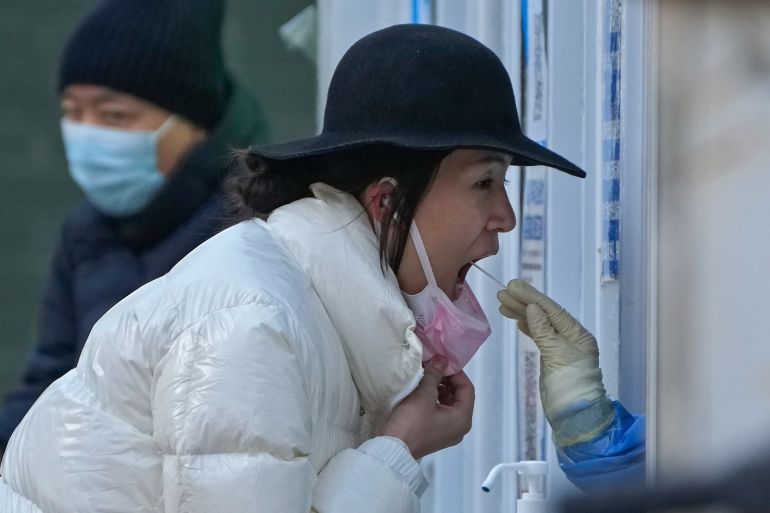More Chinese cities ease COVID curbs but full reopening unlikely
Shanghai, Urumqi are the latest to ease COVID-19 curbs following last month’s unprecedented anti-government protests.

At least a dozen cities across China have eased COVID-19 restrictions following a wave of unprecedented protests last month, with Shanghai becoming the last metropolis to scrap tests for public transport and Urumqi reopening malls and restaurants for the first time in months.
In China’s biggest city, Shanghai, where protesters had called on President Xi Jinping to step down over his “zero-COVID” policy, authorities said on Sunday that residents will no longer need a negative test result to use public transport or enter outdoor venues such as parks and tourist attractions.
Keep reading
list of 4 itemsMajor cities in China ease COVID-19 restrictions after protests
Protests in China: The blank sheets tell a tale
‘New-found freedom’: China relaxes COVID rules after protests
The easing follows similar moves by Beijing, Shenzhen, Chengdu and Tianjin, all of which cancelled the testing requirement for public transport on Saturday.
In far-western Urumqi, the capital of the Xinjiang region where the anti-government protests first erupted, authorities reopened ski resorts and malls, and allowed restaurants to open their doors for takeaway services. They said cinemas, gyms and parks will also be permitted to open gradually, with limits on the number of people allowed to enter the venues.
It was the death of 10 people in a fire at a partially locked down building in Urumqi that triggered the November protests. The city had been locked down since August.
Some social media users at the time said victims had been unable to escape the blaze because of the COVID-19 restrictions, although authorities denied that was the case.
The protests, which spread to more than 20 cities across China, were an unprecedented show of civil disobedience on the mainland since Xi took power in 2012. In the days since, at least 12 cities across the country have rolled back some of the COVID-19 curbs, according to the state-owned Global Times tabloid, in what officials described as part of an “optimisation of epidemic control measures”.
Wang Guangfa, an expert at the Peking University First Hospital, told the tabloid that the easing of curbs should not be taken as a “complete opening up”.
“We have optimised our epidemic control measures in line with the characteristics of the virus variant, striking a new balance between epidemic control and social and economic activities,” he was quoted as saying.
“It’s unlikely that we’ll walk out of the pandemic in a short time this winter,” he said, noting that many countries were seeing a rise in cases amid the cold weather.
Curbs rolled back
The steps to ease COVID-19 restrictions have so far varied across Chinese cities.
On Sunday, in the central city of Zhengzhou — home to the world’s largest iPhone plant, which was rocked by violent unrest last month — authorities said people will no longer have to show COVID-19 test results to take public transport, taxis and to visit “public areas”. But while karaoke bars, beauty salons, internet cafes and other indoor venues have been allowed to reopen, they must check for a negative 48-hour COVID test result.
Nanning, the capital of southern Guangxi, and Wuhan, the central city where the first cases of the new coronavirus emerged three years ago, also cancelled on Sunday a requirement for a negative test to take the metro.
Meanwhile, authorities in Guangzhou’s Haizhu district, which experienced violent clashes last month, said on Sunday it was advising people with no COVID-19 symptoms not to get tested for the virus unless they belong to certain groups such as front-line workers.
Beijing on Saturday also cancelled registration requirements for people wanting to buy fever, cough and sore throat medications. The restriction had been imposed because authorities believed people were using the medication to hide COVID-19 infections.
Authorities in various districts in the capital have also recently announced that people who test positive for the virus can quarantine at home.
Some inconsistencies as the restrictions are eased have angered people, including a requirement in some places for a negative COVID-19 test even though mass testing centres were closing.
In Beijing and Wuhan, that caused lengthy queues at the few remaining testing booths.
“Are they stupid or just plain mean?” one social media user asked. “We shouldn’t shut down COVID testing stations until we get rid of the COVID test pass.”
New daily case numbers dropped nationwide to 31,824, authorities said on Sunday, which may be due in part to fewer people being tested. Authorities also reported two more COVID-19 deaths.
Vaccination
Despite the easing of curbs, many experts said China was unlikely to begin significant reopening before March at the earliest, given the need to ramp up vaccinations, especially among its vast elderly population.
While nine in 10 Chinese have been vaccinated, just 66 percent of people over 80 have received one shot while 40 percent have received a booster, according to the National Health Commission. It said 86 percent of people over 60 are vaccinated.
Given those figures and the fact that relatively few Chinese have built up antibodies by being exposed to the virus, some fear millions could die if restrictions were lifted entirely.
“Some people have doubts about the safety and effectiveness of the country’s new coronavirus vaccine,” an article in the ruling Communist Party’s official People’s Daily said on Sunday.
“Experts say this perception is wrong,” it said, adding that domestically-made vaccines were safe.